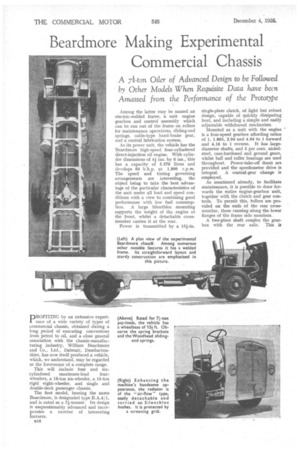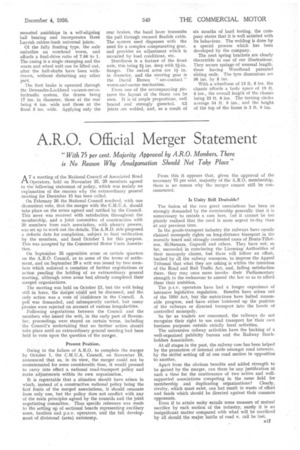Beardmore Making Experimental Commercial Chassis
Page 50

Page 51

If you've noticed an error in this article please click here to report it so we can fix it.
• A 71-ton Oiler of Advanced Design to be Followed by Other Models When Requisite Data have been Amassed from the Performance of the Prototype
DROFITING by an extensive experi
ence of a wide variety of types of commercial chassis, obtained during a long period of executing conversions from petrol to oil, and a close general association with the chassis-manufacturing industry, William Beardmore and Co., Ltd., Dalmuir, Dumbartonshire, has now itself produced a vehicle, which, we understand, may be regarded as the forerunner of a complete range.
This will include four and sixcylindered ma.ximum-load fourwheelers, a 19-ton six-wheeler, a 15-ton rigid eight-wheeler, and single and double-deck passenger chassis.
The first model, bearing the name Beardmore, is designated type B,A.4/1, and is rated as a 7i-tormer. Its design is unquestionably advanced and incorporates a number of interesting features.
816 Among the latter may be named an electric-welded frame, a unit engine gearbox and control assembly which can be run out of the frame on rollers for maintenance operations, sliding-end springs, cable-type hand-brake gear, and a central lubrication system.
As its power unit, the vehicle has the Beardmore high-speed four-cylindered direct-injection oil engine. With cylinder dimensions -of 4iins. by 6 ins., this has a capacity of 5.579 litres and develops 64 blip. at 1,800 r.p.m. The speed and timing governing arrangements are interesting, the object being to take the best advantage of the particular characteristics of the unit under all load and spccd conditions with a view to combining good performance with low fuel consumption. A large Silentbloc mounting supports the weight of the engine at the front, whilst a detachable crossmember carries it at the rear.
Power is transmitted by a 15i-in. single-plate clutch, of light but robust design, capable of quickly dissipating heat, and including a simple and easily adjustable withdrawal mechanism.
Mounted as a unit with the engine is a four-speed gearbox affording ratios of 1, 1.805, 2.94 and 4.94 to 1 forward and 4.1-6 to 1 reverse. It has largediameter shafts, and 5 per cent, nickelsteel, case-hardened and ground gears, whilst ball and roller bearings are used throughout. Power-take-off doors are provided and the speedometer drive is integral. A central-gear change is employed.
As mentioned already, to facilitate maintenance, it is possible to draw forwards the entire engine-gearbox unit, together with the clutch and gear controls. To permit this, toilers are provided on the ends of the rear crossmember, these running along the lower flanges of the frame side members.
A two-piece shaft couples the gearbox with the rear axle. This is mounted amidships in a self-aligning ball bearing and incorporates three Layrub rubber-bush universal joints.
Of the fully floating type, the axle embodies an overhead worm, and affords a final-drive ratio of 7.66 to I. The casing is a single stamping and the worm and wheel unit can be lifted out, after the half-shafts have been withdrawn, without disturbing any other part.
The foot brake is operated through the Dewandre-Lockheed vacuum-servohydraulic system, the drums being 17 ins. in diameter, those at the rear being 6 ins, wide and those at the front 3 ins. wide. Applying only the rear brakes, the hand lever transmits the pull through encased flexible cable. The system used dispenses with the need for a complex compensating gear, and provides an adjustment which is unvaried by load conditions, etc.
Sturdiness is a feature of the front axle, this being si ins, deep with 2i-in, flanges. The swivel arms are lf in. in diameter, and the steering gear is the David Brown " arc-contact " worm-and-sector mechanism.
From one of the accompanying pictures the layout of the frame can be seen. It is of ample proportions, well braced and strongly gusseted. All joints are welded, and, as a result of six months of hard testing, the company states that it is well satisfied with its behaviour. The welding is done by a special process which has been developed by the company.
The neat spring brackets are clearly discernible in one of our illustrations. They secure springs-of unusual length, these having Woodhead patented sliding ends. The tyre dimensions are 36 ins. by 8 ins.
With a wheelbase of 13 ft. 6 ins, the chassis affords a body space of 19 ft. 6 ins., the overall length of the chassis being 23 ft. 8 ins. The turning circles average 54 ft. 9 ins., and the height of the top of the frame is 2 ft. 9 ins.




























































































